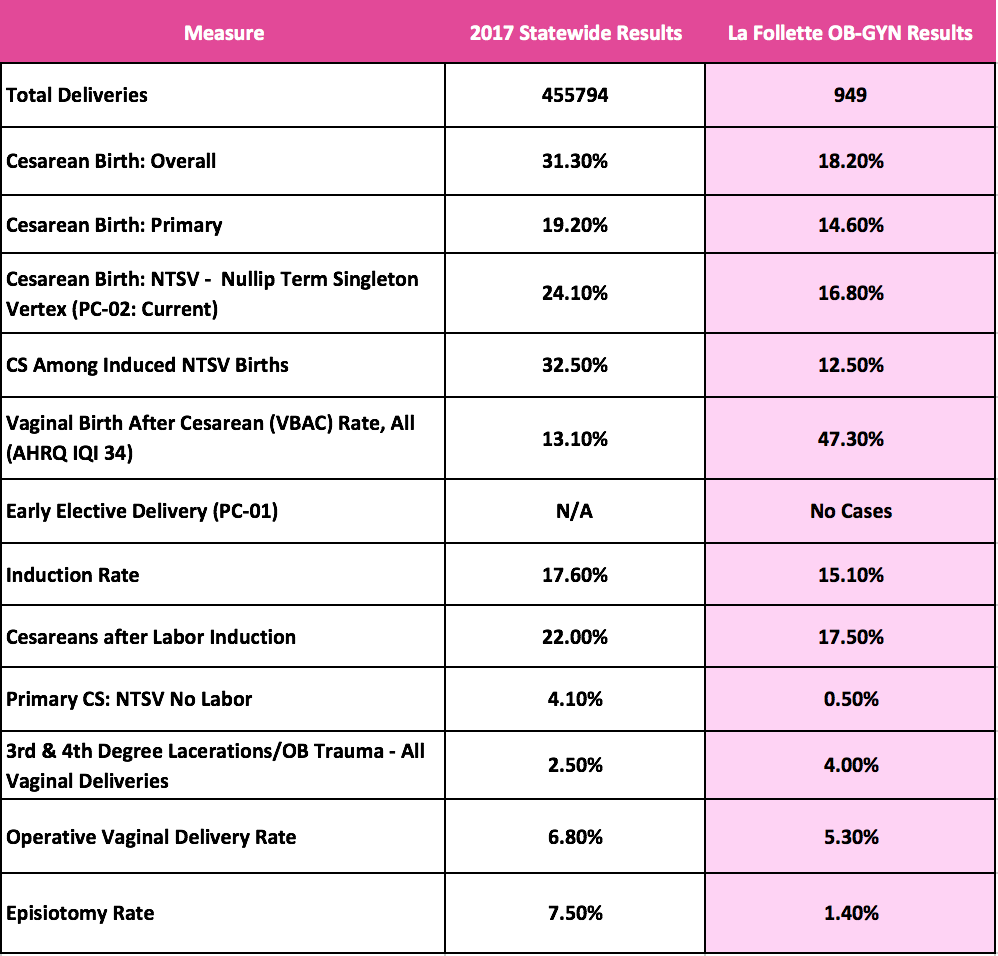Birth Rate Stats & VBAC

Between January, 2011 and August 2018, 455,794 babies were delivered in California (10,164 of which occurred at the hospital). Of those deliveries:
- 31.3% were cesarean births
- 19.2% were primary (first time) C-sections
At La Follette OB-GYN, only 14. 6% of births are primary (first time) C-sections.
Cesarean births come with multiple risks, such as hemorrhage, transfusion, infection and maternal deaths. Dr. La Follette and Dr. Dela Merced rarely perform C-sections. In fact, they are substantially below the current goal of 23%. If you’ve had a C-section in the past and you are pregnant, we want you to be given the chance of a vaginal birth.
Our VBAC rate is 47.3% compared to the 13.1% statewide rate and the 10% national rate.
The statewide VBAC rate is 13% (nationwide, it is even worse at 10%), but at La Follette OB-GYN & Aesthetics, we perform VBAC at 5 times the national and state rate! If you needed a C-section for your first pregnancy, we will ensure a safe vaginal birth with your next baby. If we have to induce you for medical reasons (overdue, diabetes, high blood pressure), we still have a very high rate of vaginal delivery–unlike the statewide numbers.

1. The first row displays total deliveries in the state and in the hospital and our contribution as a fraction of those deliveries.
2. The second row is the number of cesarean births overall : this represents a total of c-sections which is both primary (first-time c-sections) and repeat c-sections.
3. Row three is Cesarean birth primary meaning first-time c-sections. That does not mean first birth, it means first c-section so a mom with a vaginal first birth can have a primary c-section if for example her second baby was breech (meaning butt first) and we cannot turn the baby. Normally a primary c-section is the first birth, but it does not need to be.
4. Row four statistics refer to cesarean birth: NTSV which stands for nullip (first pregnancy, term after 37 weeks and 0 days; singleton (one baby); vertex: head down.
This measure was created to figure out why first-time full term moms were having c-sections. These moms are considered the most important as the first birth and its delivery method determines for most of the country (not at La Follette OB/GYN & Aesthetics) which way the next births will be. They used to say once a c-section, always a c-section and we have known since the mid 1990’s that this is not the case, but unfortunately only about 10% of obstetricians in the country will even try a vaginal birth after C-section (VBAC)..hence the more frequent repeat c-section with higher risk of bleeding and abnormal placental position (previa and acreta).
5. Row 5 illustrates c-section rates among induced NTSV, which means that the expecting mother was induced (medically starting labor rather than her going into labor on her own). It may take a very long time to get a first-time mom into labor so obstetricians try to avoid inducing when possible. I tell my patients if I have to induce, assume it will take me 24-36 hours to get you into active labor which is 6 cms dilated.
6. On the sixth row, we have VBAC rate which is defined as all moms who succeed in having a vaginal birth after a c-section divided by all those eligible for a trial of labor (aka vbac) which is all of the moms who have had one or two c-sections plus those who just had a repeat c-section. As you can see, in California this rate is a low of 13%; the hospital is 31% and my practice is 51%.
7. Row seven is the statistics of early elective delivery which is a delivery done before 39 weeks. This should not happen, hence no recorded cases.
8. Row eight is the induction rate which indicates the rate in which we medically start labor (as opposed to spontaneous labor.
9. C-section after induction rates on row nine is really trying to show that medically inducing a mom is not benign and can lead (without enough time or patience ) to a c-section which might not have happened if the woman had been left alone to go into labor on her own, which of course means waiting and we are not getting more patient these days. I like to tell my moms-to-be that there is nothing convenient about being a parent (when your kid gets sick and you have to miss work and take them into the doctor) and there is nothing convenient about labor so this is the warmup for parenting, hence why we avoid inducing first time moms (nullips) unless we absolutely have to.
10. Row ten addresses primary c-section no labor. This is a c-section at the mother’s request. I really discourage this, as a c-section is major surgery with bleeding infection risks that you do not have with a normal vaginal delivery.
11. On row eleven you see statistics for 3rd and 4th-degree lacerations which involve injuries to the muscle of the pelvic floor between the vaginal opening and the rectal opening. 3rd degree means you went through the transverse muscle, but the rectum is ok. 4th degree means it went all the way through into the rectum.
12. Operative vaginal delivery which is on row twelve is the use of a vacuum (suction cup) on the babies head or forceps (metal spoons that go around the baby’s head) to help with delivering the baby vaginally. These operative deliveries do carry more risk for injury to the mom’s pelvic floor but are usually used when the baby’s heart rate is not tolerating pushing or the mom after 3 hours (normal pushing length with an epidural ) is too exhausted to deliver the baby on her own.
13. Row thirteen is the statistic number of episiotomies. Episiotomy is a medical cut of the skin called the perineal body which is the skin and muscle between the vaginal opening and the rectum. This used to be done more frequently resulting in more tearing and more 3rd and 4th-degree lacerations. It is now recommended not to do it unless medically necessary.
At Le Follette OB/GYN & Aesthetics, we try to avoid episiotomies at all costs, as it is very important to protect a woman’s anatomy and pelvic floor strength. We also do not usually use instruments (assisted vaginal birth), and we are protective of the pelvic floor with few 3rd or 4th-degree lacerations.
Click to enlarge
Share this


